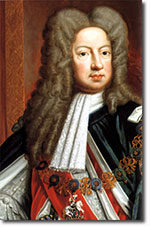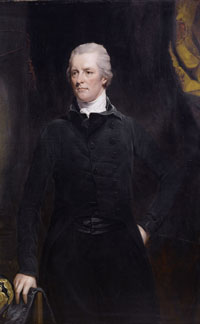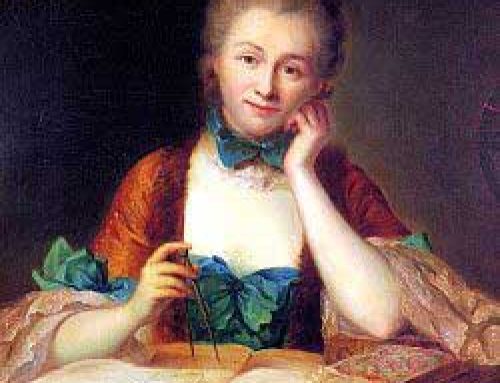
Hanoverian England: King George I of England
Why did the Hanoverians come from Germany to rule England?
Because Queen Anne had no children, and no Catholic could be king or queen, when Anne died in 1717 AD there was nobody in England to inherit the throne.
Who was Queen Anne?
What was Germany like?
All our modern Europe articles
So Anne’s cousin George – James I‘s great-grandson – became King George I of England. He came from the town of Hanover, in Germany. That started the Hanoverian Dynasty of England.
King George I of England
George was born in Germany and grew up speaking German and ruling part of Germany. And he was already 54 years old. So it seemed funny to have him become King of England! That’s why it’s Hanoverian England – it’s England under the control of a family from Hanover, in Germany.
Parliament gets more power under Walpole
Parliament took over more and more power instead, and soon the Prime Minister, Robert Walpole, made most of the decisions. Under Walpole, England’s navy got stronger and stronger. It was stronger than Spain’s navy, or any other navy in the world. British ships carried millions of enslaved Africans to the Americas.
African-American slavery
Who were the Mughals?
Louis XV in France
Walpole started to take over India from the Mughals and the French.
Walpole colonizes North America

Robert Walpole, the Prime Minister
George’s son George II ruled after him, starting in 1727, but Walpole continued to hold the real power. He made alliances with the Iroquois against the French king Louis XV and the Algonquin.
More about the Iroquois
And the Algonquin
Who were the Cherokee?
And the Shawnee?
Walpole sent settlers to conquer Cherokee and Shawnee land in North America south of the Carolinas. The invaders named their new land Georgia after the king. Cherokee leaders sailed to England to meet Walpole and try to reach an agreement, but the British just took more and more land. There was more fighting over who would control Spain, too.
Spain in the 1700s
Walpole lost power in 1742, and first Carteret and then William Pitt ended up controlling Parliament.
William Pitt as Prime Minister

William Pitt, the Prime Minister
Then in 1760 George II’s grandson ruled as George III. He was the third George of Hanoverian England!
British seize control of India
In 1775, the British army attacked the Maratha Empire to get control of northern India. They didn’t wipe out the empire, but they did take some of their land and a lot of their power.
What’s the Maratha Empire?
British India
British colonization in Africa
Then in the late 1770s Britain lost their North American colonies in the American Revolution. George III was king when Thomas Jefferson wrote the Declaration of Independence. But even though Jefferson addressed the Declaration to the King, really it was the Prime Minister, William Pitt, who was making the decisions.
The Declaration of Independence
The American Revolutionary War
Clothing factories in Europe
History of cotton
India’s economy and cotton
As a result, to keep the British spinning and weaving factories supplied with plenty of cotton, in the 1780s Pitt organized cotton-growing in British colonies in Africa, and forced Indian cotton-growers to sell raw cotton to Britain instead of weaving it into cloth.
The Opium Wars in China
But Britain was still sore about losing control of the United States. So Pitt also tried to get control of China. British traders started to sell opium from India illegally in China. Pitt was trying to get a lot of people in China addicted to opium, so they would have to buy more and more of it from British traders. The Qianlong Emperor in China tried to stop the British from selling opium in China, but he was not powerful enough.
Who was the Qianlong Emperor?
Opium Wars
What is opium?
War with France and Napoleon
In 1793, Pitt joined Austria, Prussia, and Spain in fighting against the French Revolution. By 1796, this put them all at war with Napoleon, and in 1803 they helped keep Haiti free from French control. But this turned out badly for Britain, as Napoleon sold the Louisiana Purchase to the United States to raise money for his war.
The French Revolution
Austria-Hungary
Who was Napoleon?
Haiti and the Caribbean
The Louisiana Purchase

Spencer Perceval
Spencer Perceval and the Luddites
George III’s son George IV took over in 1810, because George III was suffering from mental illness and couldn’t rule. So it was George IV’s prime minister, Spencer Perceval, who killed the leaders of the Luddites – rioting knitting-workers who wanted decent pay – and forced the rest to go back to work. Perceval also refused to help the Qajar Shah of Iran, who wanted his help to keep the Russian Czar Alexander from invading.
Who were the Luddites?
Europe’s economy in the 1800s
Iran in the 1800s
Czar Alexander in Russia
Robert Jenkinson and India
Perceval’s successor, Robert Jenkinson, ran the War of 1812, and defeated Napoleon at Waterloo. Napoleon’s defeat weakened France and left Europe divided, so that the British Empire could go on taking over big parts of the world and treating people however they wanted.
Sure enough, in 1817, Jenkinson attacked the Maratha Empire again and took control of central India too. George IV died without sons so his younger brother William became king.
Charles Grey gives the vote to more British men
Because of public protests, William’s prime minister Charles Grey passed a Reform Act in 1832 that gave the vote to many more men in England and Wales (no women could vote yet).
History of coal
After the Reform Act, about one in five adult men could vote. This was still only about 5% of the total population in England, and completely left out Britain’s colonies. Charles Grey also passed rules limiting how much children could work, which started to get children out of the coal mines and the spinning factories. More British kids started to go to school.
When William died in 1837, his daughter Victoria became the next Queen of England.
More about Queen Victoria
Did you find out what you wanted to know about Hanoverian England? Let us know in the comments!
For more about the Hanoverian dynasty, check out this Britannica article.
Victorian England
Anne of Austria in France
Cherokee and Shawnee
Bibliography and further reading about Hanoverian England:
